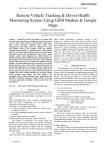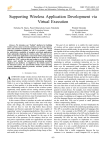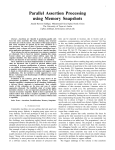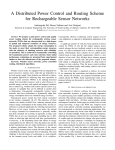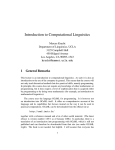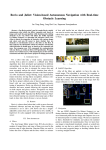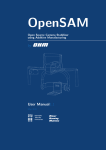Download On Mapping Distributed S-NET to the 48
Transcript
1
On Mapping Distributed S-N ET
to the 48-core Intel SCC Processor
Merijn Verstraaten, Clemens Grelck, Michiel W. van Tol, Roy Bakker, Chris R. Jesshope
Informatics Institute, University of Amsterdam
Science Park 904, 1098 XH Amsterdam, The Netherlands
Abstract—Distributed S-N ET is a declarative coordination
language and component technology primarily aimed at modern
multi-core/many-core chip architectures. It builds on the concept
of stream processing to structure dynamically evolving networks
of communicating asynchronous components. These components
themselves are implemented using a conventional language suitable for the application domain. Our goal is to map Distributed
S-N ET to the Intel SCC processor in order to provide users with
a simplified programming environment, yet still allowing them
to make use of the advanced features of the SCC architecture.
Following a brief introduction to the design principles of
S-N ET, we sketch out the general ideas of our implementation
approach. These mainly concern the use of SCC’s message
passing buffers for lightweight communication of S-N ET records
and control data between cores as well as remapping of large
data structures through lookup table manipulation. The latter
avoids costly memory copy operations that would result from
more traditional message passing approaches. Last, but not
least, we present prototypical performance measurements for our
communication primitives.
I. I NTRODUCTION
The Single-chip Cloud Computer (SCC) experimental processor is a concept vehicle created by Intel Labs as a platform
for many-core software research. It provides 48 P54C cores, an
on-chip message passing network, non cache-coherent off-chip
shared memory and dynamic frequency and voltage scaling on
different subsets of cores [1]. Creating programs for systems
which support large amounts of parallelism is already difficult;
even in the absence of specific exploitation of the power
saving features. Trying to also utilise these power management
features at the same time complicates the programmer’s job
considerably.
Currently RCCE [2] (including the community contributed
iRCCE [3]) and RCKMPI [4] are available for programming
the SCC. RCCE is an SCC-specific low-level message passing
library and RCKMPI is an adaptation of MPI largely based on
RCCE. To the best knowledge of the authors, no higher level
programming environments are (yet) available on the SCC.
While message passing is a very efficient way programming
it also requires a lot of attention to detail from the programmer.
Our goal is to make this task simpler.
S-N ET1 [5], [6], [7] is a coordination language whose aim
is to simplify the programming of parallel systems. As a pure
coordination language S-N ET provides no features to express
any sort of computation; it relies on an auxiliary language
1 The development of S-Net has been funded by the European Union through
the FP-6 project Aether and the FP-7 project Advance.
for the implementation of sequential, state-less components.
S-N ET in turn organises the interaction of these components
— called boxes — in a streaming network. A type system on
streams gives essential static guarantees on the behaviour of
S-N ET streaming networks.
Our two step approach, internally sequential components on
the one hand and orderly component interaction, somewhat
reflects the hardware design principle of the SCC and other
contemporary multicore chip architectures: cores that were
originally designed as central processing units combined on
a single die.
This paper reports on our on-going efforts to map S-N ET to
the Single Chip Cloud Computer as an alternative programming environment. Starting from our MPI-based distributed
implementation of S-N ET [7] the obvious choice is to simply
use RCKMPI as underlying middleware layer. However, the
performance of MPI is less than what can be achieved by
an implementation which uses the SCC’s hardware features
directly. Additionally MPI restricts us to a static number of
nodes, which is something which is undesirable in light of
future development directions. Instead we focussed our efforts
on implementing asynchronous message passing using the
message passing buffers (MPBs) as communication channel
and using interprocessor interrupts as out-of-band notifications. To accomplish this we had to come up with a way for
our userspace code to receive the interrupts which are being
trapped by the kernel.
In this paper we will analyse the approaches we considered
and their impact on our goal of having a programming model
which is more convenient to use than writing programs directly
using RCCE or MPI, while still capable of using the features
provided by the SCC. We will begin with an overview of
both S-N ET (Section II) and Distributed S-N ET (Section III)
before we discuss the effects of the SCC’s design on our
design (Section IV). We will discuss our initial measurements
in Section V and conclude in Section VI.
II. S-N ET
S-N ET turns functions written in a standard programming
language (e.g. C) into asynchronously executed, stateless
stream-processing components termed boxes. Each box is
connected to the rest of the network by two typed streams, one
for input and one for output. Messages on these typed streams
are organised as non-recursive records, i.e. sets of label-value
pairs. The labels are subdivided into fields and tags. Fields are
2
net X connect ((A..B | C..D)!<i>)*{<stop>}
A
B
A
B
C
D
C
D
<i>
<i>
A
B
A
B
C
D
C
D
{<stop>}
Figure 1. Example of an inductive streaming network constructed using network combinators. A, B, C and D denote boxes or networks defined elsewhere.
Then A..B|C..D denotes the subnetwork where any record either goes through A and then B or through C and then D. The actual routing depends on the
types of A, B, C and D and is left out in this figure. The whole subnetwork is then replicated in parallel based on the index i carried along by all records in
the system. At last, this network is replicated serially with the presence of stop tag acting as a dynamic drop-out condition for a records after having passed
each instance of the replicated network.
associated with values from the box language domain, they are
entirely opaque to S-N ET. Tags are associated with integer
numbers that are accessible on both the coordination and on
the box level.
A box triggers when it receives a record on its input stream,
the box then applies its box function to that record. In the
course of function execution the box may output records to its
output stream. Once the function has finished the S-N ET box
is ready to receive and process the next record on the input
stream.
On the S-N ET level a box is characterised by a box
signature; a mapping from an input type to a disjunction of
types, named the output type. For example,
box f o o ( ( a , < b > ) −> ( c ) | ( c , d , < e > ) ) ;
declares a box that expects records with a field labeled a and
a tag labeled b. The box responds with an unspecified number
of records that either have just field c or fields c and d as
well as tag e. The associated box function foo is supposed to
be of arity two: the first argument is of type void* to qualify
for any opaque data; the second argument is of type int.
The box signature naturally induces a type signature. For a
proper specification of the box interface it is essential to have
a concrete ordering of fields and tags. However, on the S-N ET
level we ignore the ordering when reasoning about boxes:
treating them as sets of labels instead of tuples of labels. Hence
the type signature of box foo is {a,<b>} −> {c} | {c,d,<e>}.
This type signature states foo accepts any input record
that has at least field a and tag b, but may well contain
further fields and tags. The formal foundation of this behaviour
is structural subtyping on records. Any record type t1 is a
subtype of t2 iff t2 ⊆ t1 . This subtyping relationship extends
to multivariant types. A multivariant type x is a subtype of y
if every variant v ∈ x is a subtype of some variant w ∈ y.
Subtyping on input types of boxes raises the question what
happens to the excess fields and tags. These are not just
ignored in the input record of a network entity, but are attached
to any outgoing record produced by it in response to that
record. Subtyping and flow inheritance are indispensable when
it comes to getting boxes that were designed separately to work
together in a streaming network.
It is a distinguishing feature of S-N ET that it neither
introduces streams as explicit objects nor defines network
connectivity through explicit wiring. Instead, it uses algebraic
formulae to describe streaming networks. The restriction of
boxes to a single input and a single output stream (SISO) is
essential for this. S-N ET provides four network combinators:
static serial and parallel composition of two networks and
dynamic serial and parallel replication of a single network.
These combinators preserve the SISO property; any network,
regardless of its complexity, again is a SISO entity.
Let A and B denote two S-N ET networks or boxes. Serial
combination (A..B) constructs a new network where the
output stream of A becomes the input stream of B, and the
input stream of A and the output stream of B become the input
and output streams of the combined network, respectively. As
a consequence, A and B operate in pipeline mode.
Parallel combination (A|B) constructs a network where
incoming records are either sent to A or to B and the resulting
record streams are merged to form the overall output stream
of the combined network; the type system controls the flow
of records. Each network is associated with a type signature
inferred by the compiler. Any incoming record is directed
towards the subnetwork whose input type better matches the
type of the record. If both branches match equally well, one
is selected non-deterministically.
The parallel and serial combinators have infinite counterparts: serial and parallel replicators for a single subnetwork.
The serial replicator A*type constructs an infinite chain of
replicas of A connected by serial combinators. The chain is
inspected before every replica to extract records that match
the type specified as the second operand.
The parallel replicator A!<tag> also replicates network
A infinitely, but the replicas are connected in parallel. All
incoming records must carry the tag; its value determines the
replica to which a record is sent.
Fig. 1 shows an example for the use of network combinators
to construct streaming networks.
3
Whereas boxes can easily split one incoming record into
multiple records sent to the output stream one after the other,
the opposite operation, i.e. merging two records on the input
stream to form a single record on the output stream, is not
possible with the means of S-N ET introduced thus far. Merging independent records is the essence of synchronisation in
the streaming context of S-N ET. To isolate this coordinationlevel feature as far as possible from the box or application
level, S-N ET uses a special built-in box for this purpose called
synchrocell. For example, the synchrocell {[|{ a , b},{c , d }|]
awaits records containing fields a/b and c/d and merges them
into a record containing all four fields. For an exact definition
of synchrocells and an extended discussion of the whole issue
of synchronisation in the context of S-N ET see [8].
We refer interested readers to [6], [5] for a detailed account
of the design of S-N ET and to [9], [10] for application
examples.
III. D ISTRIBUTED S-N ET
S-N ET as described so far is an abstract notation for streaming networks of asynchronous components. There is no notion
of computing resources in S-N ET, nor does S-N ET make any
specific assumptions about the execution environment.
Distributed S-N ET [7] is a conservative extension of S-N ET
that introduces the concept of abstract compute nodes as an
organisational layer on top of the logic network of boxes
defined by standard S-N ET.
We introduce two placement combinators. Static placement
places the execution of a box or a network onto a logical node.
Indexed dynamic placement places the execution of a box or
a network onto a logical node on a per-record basis, based on
a specific tag of that record. More precisely, each record is
routed through a replica of the box or network instantiated on
the relevant logical node.
We deliberately restrict ourselves to plain integer values
for identifying nodes to retain the advantages of an abstract
model as far as possible. The concrete mapping of numbers
to machines is implementation-dependent. Our prototype implementation of Distributed S-N ET is based on MPI where
numbers correspond to MPI task identifiers.
Implementation-wise, Distributed S-N ET takes care of initially setting up and dynamically maintaining disconnected
S-N ET streaming graphs on multiple nodes. Input and Output
managers at node-boundaries render the distributed memory
transparent by automatically serialising, transmitting and deserialising S-N ET records when moving from one node to
another.
While tags are easily sent around the network, field data can
potentially be large. In this case serialisation, transmission and
deserialisation at every node boundary between the creating
node and the consuming node of some field would be costly.
We instead transmit a qualified reference which allows the
actual data associated with some field to be fetched, ondemand, from its current location to where it is needed.
Interested readers are referred to [7] for a more thorough
introduction of the design and implementation of Distributed
S-N ET. Several case studies in [7] as well as [11] illustrate that implementing real-world distributed applications in
Distributed S-N ET is easier than using a low-level message
passing middleware directly.
IV. S-N ET ON THE SCC
Our initial work focussed on preparing the S-N ET codebase to support multiple implementations of its distribution
layer, implementing and experimenting with communication
primitives on the SCC and later, when it became available,
getting the current MPI implementation running on the SCC
using RCKMPI. As mentioned in Section II, the MPI implementation of Distributed S-N ET copies (potentially large)
application data structures by (de-)serialising them over MPI
messages. This is an expensive operation which can and should
be avoided on a shared memory machine like the SCC.
Instead of copying it should be much faster to remap the
memory from one core to another using the programmable
lookup tables (LUTs). These control the translation of memory
requests from “virtual” addresses to actual physical memory
addresses. This means that changing an entry in the LUTs lets
us move data in and out of a core’s visible memory space
without having to actually copy or move the data.
One problem with this approach is that the LUTs are behind
the L2 cache. This mean cache hits and misses are checked
before the final physical address look up is done. Hence, the
L2 cache may contain stale data, e.g. the cache contains data
at virtual address x (which translates to physical address y),
meanwhile the LUTs have been changed so virtual address x
translates to physical address z. When the core attempts to
read from virtual address x it will still read the cached data
at y instead of z.
This isn’t a problem if it is possible to — efficiently —
invalidate or flush the relevant L2 entries (or the entire L2).
However, since the P54C cores of the SCC never had an L2
cache they don’t have such an instruction. There is an L2 reset
pin available on the machine, but using it crashes the core. This
leaves two possible solutions for remapping memory: marking
the used address range as uncacheable or flushing the L2 after
every remap. Since there is no flush instruction the only way
to accomplish a flush is to manually read in a full cache worth
of data, thereby evicting the entire contents of the cache.
Aside from the big field data S-N ET also sends a large
amount of smaller meta-data messages consisting of tags.
We want to be able to quickly deal with these messages,
while wasting as little time as possible on this “non-work”
computation.
Secondly, we need to be able to deal with multiple incoming
message queues. This is important because S-N ET utilises
fixed size buffers, which propagate back pressure through the
network, to prevent a box which produces huge number of
output records from overwhelming the network.
If communication to one of the incoming queues can also
block communication to other queues, then the network suddenly becomes susceptible to deadlocks. For example, imagine
we use a synchronous communication method (like RCCE)
or an asynchronous communication method which uses the
MPB as a single queue for all incoming messages. When
a node blocks on a send — because it is synchronous or the
4
receiving MPB queue is full — the network deadlocks when
further progress of the network depends on the same node
(further down the network) doing a receive.
Since a node can have an arbitrary number of incoming
message queues, the MPB with its limited size is not suitable
for holding all incoming queues for a node. A node should
move incoming messages from the MPB to queues in its own
memory as soon as possible to keep receive space free. There
are two obvious mechanism for a core to know when to move
messages from the MPB: the core can either occasionally poll
its MPB to see if there is anything new or we can use an
out-of-band signal, in the form of an interprocessor interrupt.
The downside of polling is that when done infrequently
it can take too long to make room in the MPB for new
messages. If done too frequently time and energy are wasted.
The interrupt based approach means having to context switch
to the kernel to handle the interrupt and then context switch
back to the program. The viability of this later option depends
on the cost of a context switching.
Once the more basic work of getting S-N ET running on the
SCC is finished we intend to investigate the possibilities of
the power management features. Since not all tasks take the
same time and S-N ET propagates back pressure through the
network; there will always be one or more bottlenecks in a
network, potentially leaving the parts of the network which
are behind this bottleneck idle. The runtime system should
be capable of lowering the clock speed on these idle nodes
to save power, while increasing it on the bottleneck nodes to
increase throughput of the network.
This functionality could then be extended to take into
account that S-N ET networks are dynamic, they grow and
shrink as the computation moves through phases. Dynamically splitting and merging networks into smaller or bigger
components would allow the runtime to allocate more cores
to bottleneck tasks or deallocate cores from idle components,
potentially even shutting down cores entirely or starting them
up as computation demands.
V. M EASUREMENTS
As discussed in the previous section, there are only two
ways to deal with the possibility of stale data in the L2 cache
when remapping memory using the LUTs. Manually flushing
the entire cache or marking the memory as uncacheable.
Our measurements show that it takes approximately 1 million
cycles to flush the cache manually; plus the cost of evicting
still useful data, which has to be fetched from memory again.
The difference between L2 cache hits and L2 cache misses/uncached memory is a factor 6 writing speed reduction.
Uncached memory and L2 cache misses write at a speed of
up to 20 MB/s, cache hits write at up to 125 MB/s. For reading
the speed difference is a factor 14. Uncached memory and L2
cache misses read at up to 20 MB/s whereas cache hits read
at up to 285 MB/s.
The uncached speeds translate to a read and write speed
of approximately 102 cycles per 4 bytes, or 25.5 cycles/byte.
This means it costs 51 cycles in total to transfer one byte using
uncached memory, from here we can see that the performance
Hops
0
1
2
3
4
5
6
7
8
Remote
2.8
2.9
3.0
3.0
3.1
3.0
3.0
3.0
3.1
Kernel
4.6
4.5
4.6
4.7
4.7
4.6
4.7
4.6
4.6
Roundtrip
7.4
7.5
7.6
7.7
7.8
7.6
7.7
7.6
7.7
Table I
I NTERPROCESSOR I NTERRUPT L ATENCIES ( IN 1000 CYCLES )
penalty of disabling caches start to outweigh the 2 million
cycles required to flush two L2 caches once we want to transfer
more than 38 KB.
The Barrelfish developers already did some measurements
[12] with regard to the speed of notifications using the MPBs
and the latencies of interprocessor interrupts (IPI). But since
we plan to run in user space under Linux, unlike Barrelfish, we
are interested in how much overhead we would incur doing
this. We did all our measurements on a system running the
cores at 533 MHz and mesh network and DDR controllers
running at 800 MHz.
To free up one of the two available interrupt pins we
modified the rckmb driver to expose a kernel parameter
(using sysfs) which lets us switch between interrupt-driven and
polling mode. Next we wrote a simple Linux kernel module
which would register a handler for the freed interrupt. This
handler simply sends a POSIX signal to a user process; this
way we can use interrupts to effectively send POSIX signals
between processes running on different cores. Which signal
is send and to which user process it is sent is configured via
kernel parameters exposed using sysfs.
After the kernel module was done we had the basic infrastructure needed to test the latencies of IPIs. Each core, except
core 0, was running a simple program with an infinite loop
doing nothing and an installed signal handler which would
raise an interrupt on core 0. Core 0 was running a program
which would run through 100,000 iterations of the below steps
for every core:
1) Read the cycle counter
2) Raise an interrupt on the other core
3) Read the cycle counter upon entering the interrupt
handler in the kernel
4) Read the cycle counter again upon entering the process’
signal handler
5) Read the cycle count read inside the kernel in using the
sysfs
These tests give us three cycle counts for each iteration,
from which we can compute three time intervals: the time
it took from sending the interrupt to getting a return interrupt
from the remote core, the time from entering the kernel locally
to entering the user space signal handler and the full roundtrip
time. Table I shows the averages of these measurements under
the columns “Remote”, “Kernel” and “Roundtrip”.
5
As the table shows, the difference in hops between cores
has a negligible impact on the latency. This is as expected
when comparing the network’s high speed network with the
relatively slow core speed. However, it is surprising to see
the difference between the remote and kernel columns. The
former shows the time between raising an interrupt on the
remote core, the remote core trapping to the kernel, running its
interrupt handler, signalling the user space process and sending
an interrupt back. This took around 3000 cycles on average.
This is peculiar because the kernel time, the time between
core 0 trapping into the kernel and the user space process
receiving the signal, took around 4700 cycles and this time is
also included in the remote time measurement.
Some additional tests show that this difference always
appears between the initiating and replying core, the core who
receives the reply and prints out measurements always takes
more time to go from the kernel interrupt handler to the user
space signal handler.
A possible explanation for this behaviour is that the remote
kernel is idle aside from running the interrupt handler and the
process’ signal handler, whereas the local kernel has to access
the filesystem and execute other system calls to retrieve the
cycle counts stored by the kernel’s interrupt handler. This is
done outside of the reads from the cycle counter, so it should
not impact the measurements, but it might still evict parts of
the working set from the L1 and L2 caches causing a slow
down by needing to go to main memory.
In [12] the Barrelfish developers measure a roundtrip latency
of approximately 5000 cycles on bare metal, though this time
includes reading and writing to MPB memory twice, making
their measurements time higher than the raw IPI roundtrip
time they had. This means the overhead of running in user
space under Linux is around 2000 cycles more than bare metal.
Sending and receiving interrupts is costly, but less so than we
expected.
Using the above interrupt implementation we then implemented sending and receiving of S-N ET records using
interrupts to notify the receiver of a message. For our tests
we used records consisting of 8 bytes of metadata and 25
tags (ints) and their 25 corresponding values (ints). This is
more than the average S-N ET record should have, but still
well within range of realistic sizes. We then measured the
roundtrip latency of sending these records between two cores
to see what sort of latency we could achieve. For comparison
we also implemented a busy-waiting version of the interrupt
code, an MPI version and a RCCE version. Table II shows
the results of these measurements (averaged over 1 million
roundtrips).
For S-N ET, as mentioned earlier, we are not that interested
in low latencies and more in lightweight communication. Our
interrupt based messaging implementation outperforms the
MPI version by a good 20%, but has double the latency of the
RCCE version and almost quadruple that of its busy-waiting
equivalent.
The last column in Table II shows the average number of
cycles that the interrupt based implementation was idle each
roundtrip. This free time can be used for computational work
and makes up 75% of the roundtrip time. The RCCE and
Hops
0
1
2
3
4
5
6
7
8
Polling
5.4
5.6
6.6
5.9
6.1
6.3
6.5
6.9
7.4
RCCE
9.9
9.9
10.4
10.1
11.0
10.4
10.6
10.7
10.8
MPI
25.7
25.8
26.2
26.2
26.6
26.7
27.3
27.0
26.8
Interrupt
18.8
21.0
21.8
21.2
21.6
21.6
21.6
22.2
22.4
Free
14.4
16.2
16.9
16.2
16.6
16.4
16.4
16.8
17.0
Table II
ROUNDTRIP MESSAGING LATENCY ( IN 1000 CYCLES )
polling implementations on the other hand waste their time
in a busy-wait loop, preventing the core from doing useful
computation. This problem can of course be diminished by
polling every n micro-/miliseconds instead of busy-waiting, at
the cost of increased the latency.
It would be interesting to compare the efficiency of various
polling intervals for the polling and RCCE implementations
and see whether a trade-off in latency can improve their
efficiency to be on par with that of the interrupt implementation. Unfortunately we did not have time to finish these
measurements and include them in this paper. The biggest
problem in measuring this information is the granularity of
the Linux scheduler. Most ways for a thread to yield its
execution (so computational code can run) cause the next
poll to be postponed until the next time the scheduler runs
it. This causes blocks to last far to long for the polling to be
effective. To solve this problem we will need to utilise Linux’
real time scheduling support to make suspending the polling
threat frequently for intermediate amounts of time feasible.
VI. C ONCLUSION
In this paper we have introduced the declarative coordination language S-N ET. It is designed to provide a more convenient way of programming for multi-core/many-core chip
architectures by viewing programs as independent components
with an input and output stream. These components are then
used to construct programs using a set of combinators.
We sketched out our ideas for implementing the S-N ET
runtime system on top of the SCC. Focussing on the two
most important short-term goals for S-N ET: utilising the
LUT capabilities of the SCC to eliminate needless copying
of data by being able to quickly remap it and using the
message passing buffers and on-chip network to implement a
lightweight communication mechanism for S-N ET’s records.
In the near future we also want to investigate the ability to
dynamically change the power and speed at which the cores
run, allocating more resources to bottlenecks in the S-N ET
network and reducing the energy wasted by the parts which
are idle.
After this presentation of our ideas we went on to discuss the
various tests we implemented, their performance and how their
results impacts our ideas for S-N ET. We determined that the
latencies for sending interrupts are not as small as we would
6
like, but are low enough what we need. Combined with the
message passing buffers they provide us with enough to let us
implement lightweight asynchronous message passing.
Unfortunately we were not able to finish implementing tests
to compare the efficiency of asynchronous messaging to our
polling and RCCE implementations (using various polling intervals), this means we don’t have a conclusive “best” solution,
but the numbers for our asynchronous implementation make
us cautiously optimistic about how well it will stack up against
the polling and RCCE implementations.
The biggest problem we encountered during our work was
the lack of control over the L2 cache. Without control over
the cache’s behaviour it is difficult to accurately predict the
performance (and in some cases correctness) of code. Making
it difficult to accomplish some of the things we want to do,
such as remapping memory using the LUTs. We can work
around this, but at the cost of convenience and performance.
[4]
[5]
[6]
[7]
[8]
[9]
R EFERENCES
[1] J. Howard, S. Dighe, Y. Hoskote, S. Vangal, D. Finan, G. Ruhl,
D. Jenkins, H. Wilson, N. Borkar, G. Schrom, F. Pailet, S. Jain,
T. Jacob, S. Yada, S. Marella, P. Salihundam, V. Erraguntla, M. Konow,
M. Riepen, G. Droege, J. Lindemann, M. Gries, T. Apel, K. Henriss,
T. Lund-Larsen, S. Steibl, S. Borkar, V. De, R. V. D. Wijngaart, and
T. Mattson, “A 48-core IA-32 message-passing processor with DVFS in
45nm CMOS,” pp. 108–109, feb. 2010.
[2] R. F. van der Wijngaart, T. G. Mattson, and W. Haas, “Light-weight communications on intel’s single-chip cloud computer processor,” SIGOPS
Oper. Syst. Rev., vol. 45, pp. 73–83, February 2011.
[3] C. Clauss, S. Lankes, P. Reble, and T. Bemmerl, “Evaluation and
improvements of programming models for the Intel SCC many-core
[10]
[11]
[12]
processor (accepted for publication),” in Proceedings of the International Conference on High Performance Computing and Simulation
(HPCS2011) – to appear, Workshop on New Algorithms and Programming Models for the Manycore Era (APMM), (Istanbul, Turkey), July
2011. accepted for publication.
Intel, “RCKMPI User Manual,” February 2011.
C. Grelck, A. S. (eds):, F. Penczek, C. Grelck, H. Cai, J. Julku,
P. Hölzenspies, S. Scholz, and A. Shafarenko, “S-Net Language Report
2.0,” Technical Report 499, University of Hertfordshire, School of
Computer Science, Hatfield, England, United Kingdom, 2010.
C. Grelck, S. Scholz, and A. Shafarenko, “Asynchronous Stream Processing with S-Net,” International Journal of Parallel Programming,
vol. 38, no. 1, pp. 38–67, 2010.
C. Grelck, J. Julku, and F. Penczek, “Distributed S-Net: High-Level
Message Passing without the Hassle,” in 1st ACM SIGPLAN Workshop
on Advances in Message Passing (AMP’10), Toronto, Canada, 2010
(G. Bronevetsky, C. Ding, S.-B. Scholz, and M. Strout, eds.), ACM
Press, New York City, New York, USA, 2010.
C. Grelck, “The essence of synchronisation in asynchronous data flow,”
in 25th IEEE International Parallel and Distributed Processing Symposium (IPDPS’11), Anchorage, USA, IEEE Computer Society Press,
2011.
C. Grelck, S.-B. Scholz, and A. Shafarenko, “Coordinating Data Parallel
SAC Programs with S-Net,” in 21st IEEE International Parallel and
Distributed Processing Symposium (IPDPS’07), Long Beach, USA, IEEE
Computer Society Press, 2007.
F. Penczek, S. Herhut, C. Grelck, S.-B. Scholz, A. Shafarenko, R. Barrière, and E. Lenormand, “Parallel signal processing with S-Net,”
Procedia Computer Science, vol. 1, no. 1, pp. 2079 – 2088, 2010. ICCS
2010.
F. Penczek, S. Herhut, S.-B. Scholz, A. Shafarenko, J. Yang, C.-Y. Chen,
N. Bagherzadeh, and C. Grelck, “Message Driven Programming with
S-Net: Methodology and Performance,” Parallel Processing Workshops,
International Conference on, vol. 0, pp. 405–412, 2010.
S. Peter, T. Roscoe, and A. Baumann, “Barrelfish on the Intel Singlechip Cloud Computer,” Tech. Rep. Barrelfish Technical Note 005, ETH
Zurich, September 2010. http://www.barrelfish.org.






